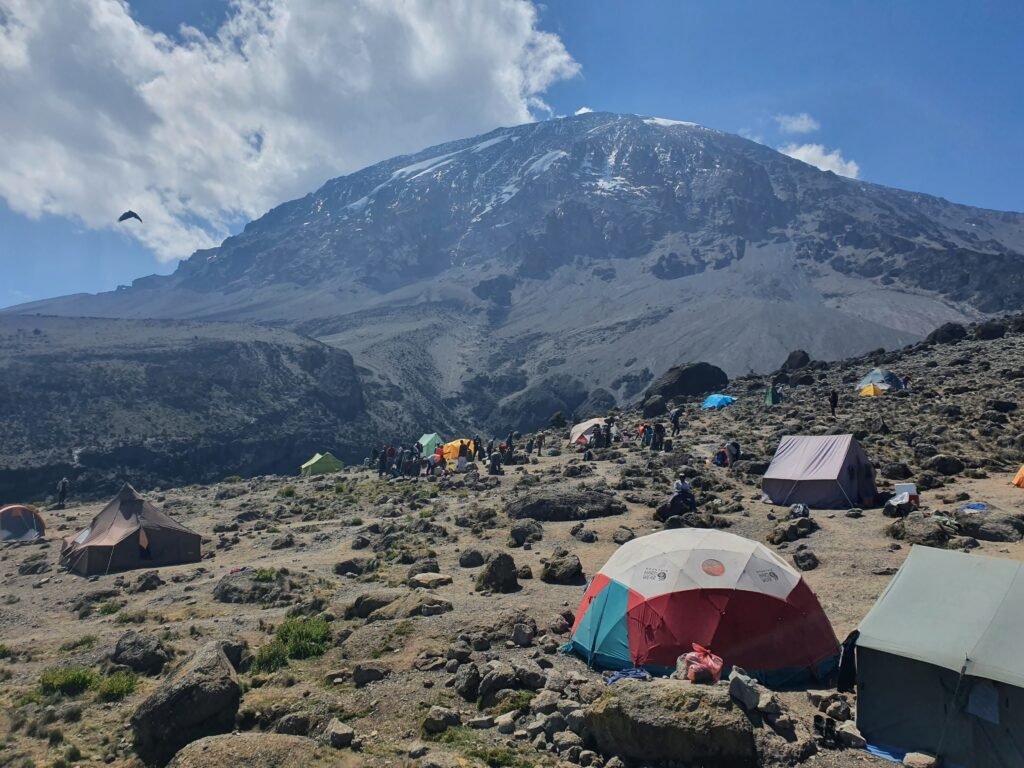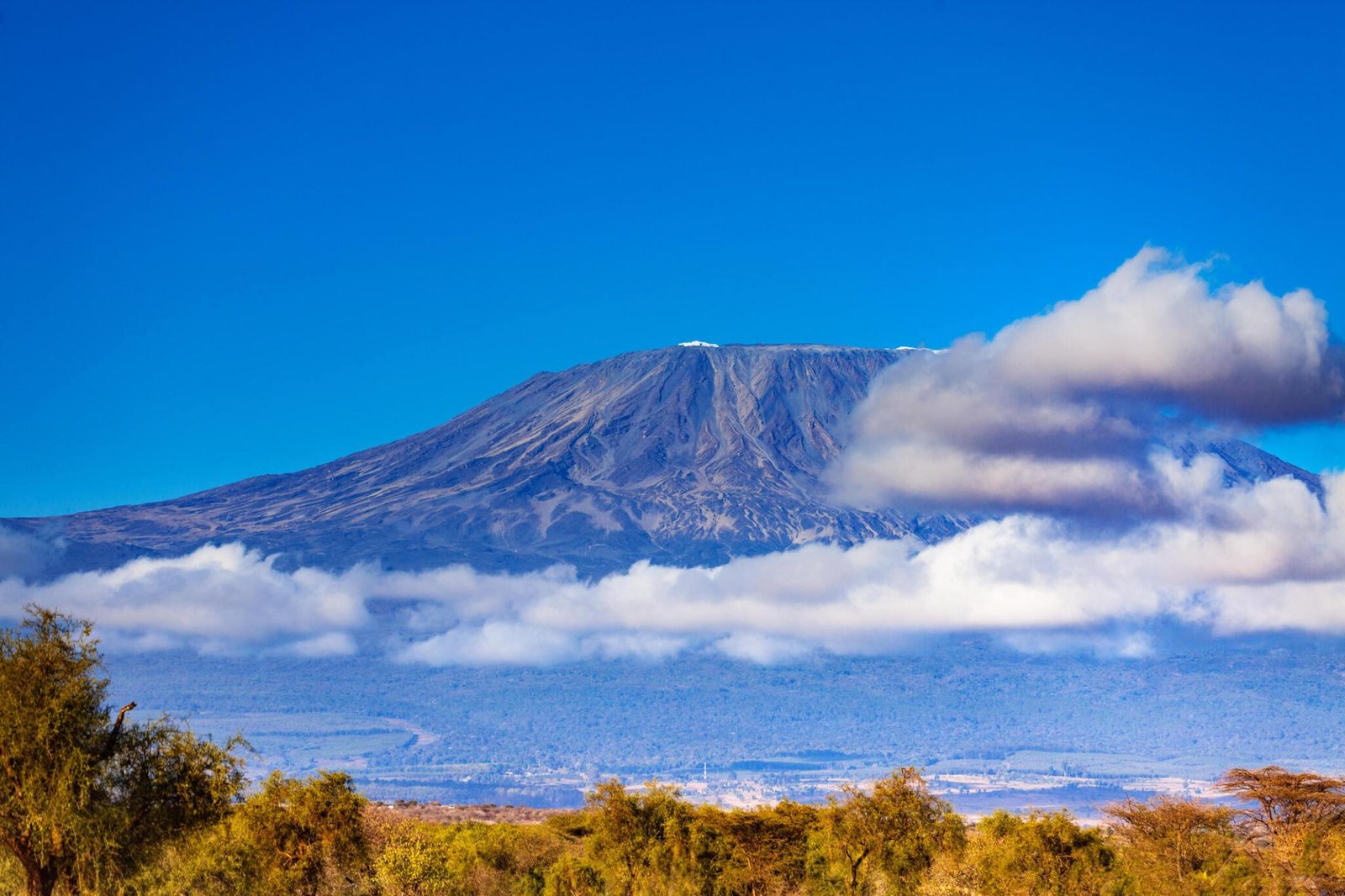Mount Kilimanjaro, Africa’s tallest mountain, draws adventurers from across the globe seeking to stand atop its summit. But what exactly can you expect when you reach the top of this iconic peak? From the awe-inspiring views to the glaciers and landmarks, the experience is like no other. In this post, we will explore what awaits climbers at the top of Mount Kilimanjaro and why it’s considered one of the most rewarding achievements in the world of adventure.
Explore expert-guided Kilimanjaro climbs here.

1. The Summit: Uhuru Peak
At the top of Mount Kilimanjaro lies Uhuru Peak, which stands at 5,895 meters (19,341 feet). It is the highest point in Africa and a dream destination for trekkers worldwide. Reaching Uhuru Peak is the culmination of days of hiking through diverse landscapes, from lush rainforests to arctic-like conditions near the top.
- Uhuru Peak: The highest point on the mountain, marked by a famous sign where climbers can take their victory photos.
- Temperature: Extremely cold at the summit, often below freezing, with strong winds and thin air.
Learn more about Kilimanjaro’s summit and its conditions here.
2. The Iconic Glaciers
One of the most stunning features at the top of Mount Kilimanjaro is its glaciers. Though they are rapidly melting due to climate change, these glaciers offer a surreal and stark contrast to the volcanic rock that makes up most of the mountain. The most famous glaciers include the Furtwangler Glacier and the remnants of the ice cap that once covered the entire summit.
- Furtwangler Glacier: A shrinking yet magnificent glacier at the summit.
- Climate Change: Kilimanjaro’s glaciers are projected to disappear within the next few decades.
Read more about the fate of Kilimanjaro’s glaciers.
3. Stella Point: A Major Achievement
Before reaching Uhuru Peak, most climbers pass through Stella Point. Located at 5,756 meters (18,885 feet), this is where many climbers first experience a sense of accomplishment. While not the ultimate summit, reaching Stella Point is a significant milestone on the journey to Uhuru.
- Why It’s Important: Stella Point is a resting spot where climbers take a break before the final push.
- Breathtaking Views: Stella Point offers spectacular views of the crater and surrounding landscapes.
Discover more about Stella Point and what it represents.
4. Reaching the Crater: Kilimanjaro’s Volcanic Heart
Mount Kilimanjaro is a dormant volcano, and at its summit, you will find the Kibo Crater. The crater is a stark, barren landscape, showing the mountain’s volcanic origins. Some adventurous climbers take the time to explore the crater rim, which offers unique geological features and a chance to experience the mountain’s raw beauty.
- Kibo Crater: An awe-inspiring volcanic crater near the summit.
- Volcanic Origins: A reminder of Kilimanjaro’s dormant volcanic history.
Learn more about Kilimanjaro’s volcanic activity and crater exploration.
5. The View: The Roof of Africa
One of the biggest rewards of reaching the summit of Kilimanjaro is the breathtaking view. On a clear day, climbers can see hundreds of kilometers across Tanzania and Kenya. The sunrise from the summit is particularly beautiful, illuminating the vast plains and landscapes below.
- Panoramic Views: A once-in-a-lifetime opportunity to take in the vast African landscape from above the clouds.
- Sunrise: Many climbers time their summit so they can witness the sun rising over Africa, a spectacular sight.
Find out more about what makes Kilimanjaro’s summit view so spectacular.
6. The Famous Uhuru Peak Sign
A visit to the summit isn’t complete without a photo in front of the iconic Uhuru Peak sign. This wooden sign is a rite of passage for climbers who have made it to the top. It reads “Congratulations, you are now at Uhuru Peak, Tanzania, 5,895 M AMSL, Africa’s Highest Point.”
- Uhuru Peak Sign: The most sought-after photo op for Kilimanjaro climbers.
- Symbol of Achievement: A memorable moment where climbers can celebrate their incredible journey.
Read more about the history of the Uhuru Peak sign.
7. Thin Air: The Challenge of High Altitude
Reaching the top of Kilimanjaro is not just a physical challenge—it’s a mental one as well. The air at the summit is very thin, with only half the oxygen found at sea level. This makes it difficult to breathe and can cause symptoms of altitude sickness. Most climbers don’t spend more than 15-20 minutes at the summit due to the harsh conditions.
- Altitude Sickness: Common at such high elevations, causing symptoms like headaches, nausea, and dizziness.
- Oxygen Levels: At the summit, the oxygen levels are significantly lower, making it harder to breathe.
Learn more about managing altitude sickness on Kilimanjaro.
8. A Sense of Achievement
Reaching the summit of Mount Kilimanjaro is a deeply rewarding experience. The sense of accomplishment climbers feel as they stand at the “Roof of Africa” is unparalleled. For many, the climb represents a personal challenge, a test of endurance, and a transformative journey that they will carry with them for the rest of their lives.
- Personal Achievement: Many climbers reflect on their inner strength and resilience after completing the climb.
- Life-Changing Experience: Kilimanjaro’s summit is more than just a physical feat; it’s an emotional and mental triumph as well.
Explore why climbing Kilimanjaro is a life-changing experience.
9. Unique Wildlife: Birds Above the Clouds
Though the summit is mostly barren, some hardy wildlife can still be spotted near the top of Kilimanjaro. Birds like Alpine Chats and Lammergeyer Vultures have been sighted near the summit, living in these extreme conditions.
- Birds of Prey: Lammergeyers and other vultures can sometimes be seen circling the summit.
- Alpine Chats: These small birds are among the few creatures that thrive at Kilimanjaro’s highest elevations.
Read more about wildlife spotted near Kilimanjaro’s summit.
10. The Rapid Descent: What Happens After the Summit?
After spending some time at the summit, climbers typically begin their descent. The journey down is much faster than the ascent, with many climbers returning to a lower camp in just a few hours. The descent is less physically demanding, but still requires care as tired legs can make navigating steep trails tricky.
- Quick Descent: Most climbers return to a lower camp on the same day as summiting.
- Relief from Altitude: As climbers descend, the oxygen levels increase, and many start feeling better after experiencing altitude symptoms at the top.
Discover more tips on descending safely from Kilimanjaro.
Conclusion
Reaching the top of Mount Kilimanjaro is a truly incredible achievement, offering breathtaking views, glaciers, and the famous Uhuru Peak sign as rewards for the grueling trek. While the air is thin and the temperature cold, the sense of accomplishment and beauty that awaits makes every step worth it. Whether you’re drawn to the challenge, the views, or simply standing at the highest point in Africa, the summit of Kilimanjaro is a place like no other.
For more information on planning your Kilimanjaro climb, visit Kilimanjaro Climb Specialist or Eddy Tours & Safaris.

